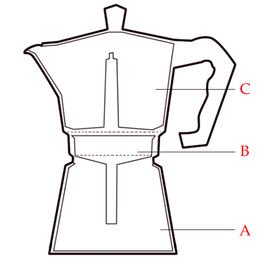Coffee Percolator
DDV CULINARY
A coffee percolator, caffettiera, is a type of pot used to brew coffee. Coffee percolators once enjoyed great popularity, but percolated coffee has more recently been largely replaced by the French press, the drip brew and a renewed interest in espresso coffee. Percolators still have a following, since the coffee has a distinctive quality that some particularly appreciate. There are two basic types of percolator: the first forces boiling water under pressure through the grounds into a separate chamber, while the second continually cycles the boiling brew through the grounds using gravity until the required strength is reached. Naming ConventionDue to the fact that they operate in completely different manners, and produce different end results, marketers usually apply name of "percolator" to the gravity type. The second type, due to its prevalence in Italy and use of pressure to brew, is often called a stove top espresso pot. Pressure Type
A 'moka' coffee pot

Cross-section through a coffee percolator
The most common type of percolator used today (other than the electric gravity type percolator used in most American households) is known as a espresso coffee pot or, in some regions, especially Italy, as a Moka or Moka pot. In Italy, Spain and Portugal, the moka pot is the most popular way of brewing coffee at home, and its usage has spread to the USA. This type is shown below right, and is comprised of three sections, all usually made of metal, which screw together such that the steam pressure created in the pot is contained during use. Water is placed in the lower section (marked A) and the raw coffee grounds in the mid-section (marked B) with the spout reaching below the water level. After the top section, initially empty, is affixed, the pot is placed on a heat source. As the water reaches boiling point it turns to steam and eventually creates sufficient pressure to force all the water from the lower section up the tube at once, through the grounds — which are held in place by a metal filter either side — and through a second tube until it hits the lid of the pot and is collected in the upper section (C), producing a strong, concentrated coffee. Gaskets and safety valves to ensure a tightly closed unit allow for pressure to safely build up in the lower section and provide a necessary security release if this pressure gets too high. The resultant coffee can be very strong but there is no crema. A variation of this type of percolator has no upper chamber, but ejects the brew directly into a cup via the upper tube — this will have a crema. These coffee pots are normally made of aluminum or stainless steel. The Bialetti company of Omegna, Italy has done the most to popularize this method of brewing and has developed a new model that claims to extract some oils and flavors similar to coffee brewed in the true espresso fashion. Gravity TypeThe second type of percolator consists of a pot with a small chamber at the bottom, which is placed closest to the heat source. A vertical tube leads from this chamber to the top of the percolator. Just below the upper end of this tube is a perforated chamber. The percolator is prepared for use by placing the desired quantity of water in the pot, and a corresponding amount of a fairly coarse grind of coffee in the top chamber. It is important that the water level should be below the bottom of the coffee chamber. After the percolator is placed on the heat source (such as a stove), the temperature rises until the water in the bottom chamber boils. A one-way valve at the bottom of the tube forces some of the boiling water up the tube, and it is distributed at the top over the perforated lid of the coffee chamber. This water then seeps through the coffee grounds and leaves the coffee chamber through the bottom, dropping back into the lower half of the pot. The rest of the colder water at the bottom is meanwhile also forced up the tube, causing this whole cycle to repeat continually. As the brew continually drips through the grounds, the overall temperature of the liquid approaches boiling point, at which stage the "perking" action (the characteristic spurting sound the pot makes) stops, and the coffee is ready for drinking. In a manual percolator it is important to remove or reduce the heat at this point, as most coffee-drinkers agree that it should never be allowed to boil; an adage to this effect states, "Coffee boiled is coffee spoiled". Brewed coffee left on high heat for too long will also acquire a bitter taste. Some coffee percolators have an integral electric heating element, and should obviously never be used on a stove. Most of these automatically reduce the heat at the end of the brewing phase, keeping the coffee at drinking temperature but not boiling. UsagePercolators are often popular among campers and other outdoorsmen due to the ability to make coffee without electricity. This article is licensed under the GNU Free Document LicenseIt uses material from Wikipedia. |